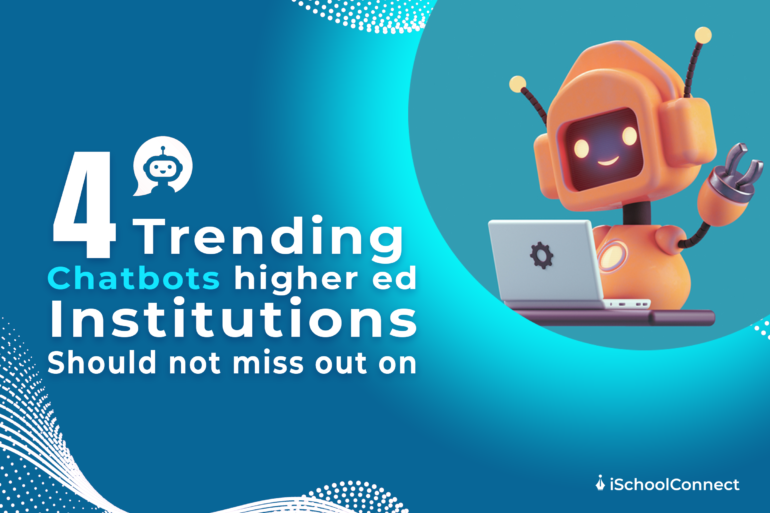Last Updated on December 16, 2024 by iSchoolConnect
When chatbots were introduced, experts were unsure if the new artificial intelligence technology would persist and become a standard in organizations and higher education. In a keynote address, Mark Zuckerberg initially revealed his vision for a Facebook Messenger, saying that it would act like a chatbot and explaining how chatbots may converse using simple, pre-programmed scripts that allow users to perform basic activities.
After a few years, AI technology has become more valuable than ever and is more accessible to both small enterprises and institutions of higher learning.
- The AI chatbots market is projected to reach $22.6 billion by 2031, growing at a CAGR of 27.8% during the forecast period 2024–2031.
- Over 70% of students in America use AI chatbots for schoolwork, according to a survey of 306 students (grades 6–12) conducted by researchers from Carnegie Mellon University and the University of California, Santa Barbara.
- AI in education is predicted to be worth over $88 billion in the next decade, as per Allied Market Research.
- Even though the general public seems to have had only a handful of experience with chatbots, Business wire says that customers are growing more receptive to them. The younger generations, Generation Z and Millennials, are more likely to say that chatbots help people solve problems swiftly.
Institutions are expected to offer instructional resources, such as eBooks, films, manuals, or infographics, to aid incoming students throughout their application and enrollment journey. But promoting appropriate materials to potential students at various journey phases manually is no longer sufficient.
The current prospective student experience must be frictionless and seamless. This involves responding to students’ inquiries immediately, making it easier for them to discover the most relevant information in time. One way to do this is through conversational chatbots, which are becoming an increasingly popular communication channel amongst institutions and prospective students.
What is a chatbot?
A chatbot is a text or speech-based conversational interface that allows users to communicate their wants, worries, or inquiries using voice or text. In certain circumstances, human intervention is required to assist chatbots. Still, in most instances, a chatbot can carry out an entire conversation with a customer as long as the questions asked fall under its knowledge. In a nutshell, chatbots are built to process information and reply to humans using a pre-programmed script.
Chatbots, also known as virtual assistants, are being marketed by many of the leading technology businesses, including IBM, Amazon, Facebook, Google, and Microsoft, as a method to transform daily activities and the way people engage. Chatbots are becoming increasingly adept at adjusting their pre-programmed replies to user requests and enhancing responsiveness.
Chatbots are also making inroads into education. A chatbot dubbed “Jill Watson” works as a teaching assistant in an online AI course at the Georgia Institute of Technology, where she answers common inquiries asked by students. When Jill was first introduced in 2016, pupils had no idea she wasn’t human until the last day of class. At Carnegie Mellon University, researchers developed conversational agents to facilitate collaborative talks among students online. These are only two of the hundreds of instances in which chatbots are being used in higher ed today.
How do chatbots work?
Three basic categorization algorithms are employed in order to run a chatbot-
- Pattern-matching bots categorize text and respond depending on the terms they encounter in the queries they are asked. They only know the answers to the questions existing within their models, and as a result, are limited to the ways previously programmed into their systems.
- Algorithms are another way of programming chatbots. A distinct pattern must be stored in a database for each query type for the chatbot to respond appropriately, and a hierarchical structure can be created by combining several trends. Developers use algorithms to decrease the number of classifications and make the design more understandable.
- The third and most important approach for designing chatbots is using artificial neural networks. These technologies allow bots to calculate the answer to a query utilizing weighted connections and context. Each statement supplied to the bot is split into separate words, and each word is input to the artificial neural network. Over time, the network becomes increasingly sophisticated, allowing the bot to develop a more accurate collection of replies to typical requests.
Three types of chatbots
There are three types of chatbots accessible today-
- Rule-based chatbots. One of the most basic options, these bots merely respond to detailed inquiries with a pre-defined answer. They are ideal for tasks such as lead qualification or providing users with an engaging FAQ experience.
- Intelligent chatbots. These intelligent chatbots learn from the user’s requests and information using machine learning, or “ML.” Intelligent bots are taught to recognize specific terms/expressions that elicit responses. They train themselves to comprehend more queries and provide better answers over time.
- AI-powered chatbots. These bots tackle user problems by combining the advantages of rule-based bots with the strength of cognitively autonomous programs. They are capable of remembering the context of discussions and comprehending user preferences and employ natural language, machine learning, and AI to understand clients.
Benefits of using AI chatbots

1. Help students make better choices
- Students are often concerned about choosing the right career. They want to be sure that they select the appropriate courses based on academic goals, budget, and prospective opportunities.
- AI-powered chatbots can help universities interact with and recruit students who are interested in the programs they provide. They can route learners to specific web pages, display course explanatory videos, and assist them in making sound decisions by using well-designed discussion flows.
- This can assist institutions in obtaining a more significant number of course applications and increasing enrollments.
2. Simplify the enrollment process
- Every year, an increasing number of universities are installing bots to address the most frequently asked questions posed by admitted students.
- These queries can be about the university’s campus, amenities, scholarships and perks, and admission. Chatbots may also aid students with registration and login procedures for online platforms and provide solutions to other common dilemmas.
- This guarantees that the incoming class of students expects to feel at ease on campus and hence ends up enrolling at the institution.
3. Offer omnichannel support
- Millennials and Gen Z are known to seek instant responses and solutions to their predicaments. Many institutions are incorporating automated student support services to satisfy the demands of these young adults.
- Automated bots provide another layer of communication to institutions, managing day-to-day conversations 24×7, replying to routine queries, and escalating complex issues when necessary.
- Moreover, conversational AI bots learn from their mistakes as they engage with more and more people, figuring out how to tackle more complicated queries and scenarios over time.
4. Provide a better learning environment
- Through AI-driven chatbots, universities can provide a customized learning environment to their students, making it easier for teachers to contact, educate, and advise students and answer their questions on the go.
- When trained well, AI bots can learn how to assess each student’s level of knowledge throughout the course.
- Evaluating how students respond, they can employ intelligent tutoring systems that provide superior learning experiences. These systems are designed to share relevant resources, drop helpful comments, and ensure that each student is learning at a favorable pace.
5. Share relevant, personalized content
- Chatbots can help institutions provide pupils with customized information. They may keep students up to speed on orientations, on-campus activities, placements, and other events and announcements that may interest them.
- Universities can also connect the bot to the database to notify students of payment dues, charges, project deadlines, assessment data, courses completed/remaining, etc.
- Providing such customized information ensures effective student engagement and also boosts the university’s credibility and reputation.
6. Collect student data
- AI chatbots gather a hoard of data while enrolling and engaging students in order to understand their personalities and interests.
- This information, when processed effectively, can assist institutions in identifying areas that they need to work on in order to improve the overall student experience.
- For example, if many students desire to learn more about a specific topic, the university may create a new webpage sharing that information. Similarly, noticing that students are facing difficulties finding a particular portion of the website may urge the institute to enhance its site navigation.
Four best chatbots for higher education

img-alt;digital-chatbot-notifications-message-alert-screen-icon-sent-recipient-laptop-artificial-intelligence-innovation-technology.;AI chatbots help universities answer numerous questions asked by prospective students.
1. CASIE
- Developed by iSchoolConnect, CASIE is an AI-based conversational chatbot that answers prospective and current students’ queries. It can be customized to respond to specific questions about programs, application requirements, services, etc.
- The bot is designed to ensure that, in case students are not satisfied with the provided answer, they have the opportunity to connect with a human agent. Meanwhile, it learns from past conversations and improves upon its answers to improve its performance.
- Through CASIE, universities can improve engagement on their websites and use the data to boost enrollments and engagement.
2. HubSpot chatbot
- HubBot is an artificially intelligent chat service that is akin to IBM Watson and Amazon’s QnABot. It can arrange appointments, interact with your current HubSpot CRM, track conversations in an easy-to-filter manner, and answer simple inquiries based on a pre-loaded script.
- The bot is designed to automate conversations while appearing genuine, almost as though the responses were written by a human being.
- The organization has gone out of its way to make the HubBot user experience as simple as possible; students will appreciate how simple it is to interact with.
3. Pounce
- In 2014, Georgia State University developed a systematic strategy to address summertime melt.
- The institution recognized typical enrollment barriers that students confront between high school graduation and the start of college. Like financial assistance applications and paperwork, vaccination records, placement examinations, and course registration. Then, they devised a strategy to assist at-risk students in overcoming these challenges.
- A new student gateway and an artificial-intelligence-enhanced chatbot, “Pounce,” were instituted to answer tons of questions from incoming students via text messages 24×7. As a result, the student drop-out rate was reduced by 22 percent!
4. BobChat
- BobChat, which is available to both national and international students, shares information on NYU’s campuses, curriculum, student life, etc. with prospective students. It is an exceptional service that responds rapidly to students’ queries 24X7.
- Powered by Facebook Messenger, the bot is supported by a friendly team ready to help students find answers to their problems, gather and share feedback, and explore all things NYU.
- It has the following features-
- Freeform: Students can type their questions at any point in time.
- Buttons: Students can get quick information by clicking on premade, suggestive buttons.
- Live Chat: Students have to type “human” to speak with the support team.
- Feedback: Students can leave comments about their experience with BobChat or NYU.
Conclusion
- An AI chatbot may deliver rapid responses to library inquiries, sign students up for new classes, and direct them to the admissions department, making self-service much easier for incoming and existing students.
- Because chatbots never sleep, overseas students can “speak” to university representatives any day or night, regardless of the university’s local time.
- Conversational AI bots can sift through hundreds of registration papers in seconds, offering relevant information when needed.
- They are ideal for enrollment, financial assistance, residence availability, fees and address, and answering other fundamental inquiries about university paperwork from potential students. If the questions asked are too complicated, a person can step in before the user ends up feeling disappointed.
- Conversational AI usage at colleges and universities is a step towards the future of higher education.







